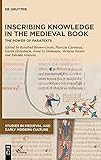Inscribing Knowledge in the Medieval Book : The Power of Paratexts / ed. by Rosalind Brown-Grant, Patrizia Carmassi, Gisela Drossbach, Anne D. Hedeman, Victoria Turner, Iolanda Ventura.
Material type: TextSeries: Studies in Medieval and Early Modern Culture ; 66Publisher: Kalamazoo, MI : Medieval Institute Publications, [2020]Copyright date: ©2020Description: 1 online resource (XVI, 395 p.)Content type:
TextSeries: Studies in Medieval and Early Modern Culture ; 66Publisher: Kalamazoo, MI : Medieval Institute Publications, [2020]Copyright date: ©2020Description: 1 online resource (XVI, 395 p.)Content type: - 9781501517884
- 9781501513114
- 9781501513329
- online - DeGruyter
- Issued also in print.
| Item type | Current library | Call number | URL | Status | Notes | Barcode | |
|---|---|---|---|---|---|---|---|
 eBook
eBook
|
Biblioteca "Angelicum" Pont. Univ. S.Tommaso d'Aquino Nuvola online | online - DeGruyter (Browse shelf(Opens below)) | Online access | Not for loan (Accesso limitato) | Accesso per gli utenti autorizzati / Access for authorized users | (dgr)9781501513329 |
Frontmatter -- Contents -- List of Figures -- Editorial Principles -- Preface and Acknowledgments -- Introduction -- Part 1: Constructing Bodies of Knowledge -- 1. Juridical Late Medieval Paratexts and the Growth of European Jurisprudence -- 2. Prefaces in Canon Law Books -- 3. “Depingo ut ostendam, depictum ita est expositio:” Diagrams as an Indispensable Complement to the Cosmological Teaching of the Liber Nemroth de astronomia -- Part 2: Negotiating Tradition, Creating Practice -- 4. From Text to Diagram: Giambattista Da Monte and the Practice of Medicine -- 5. Immortal Souls and an Angel Intellect: Some Thoughts on the Function and Meaning of Christian Iconography in Medieval Aristotle Textbooks -- 6. Writing in the Margin – Drawing in the Margin: Reading Practices of Medieval Jurists -- 7. Structuring, Stressing, or Recasting Knowledge on the Page? Rubrication in the Manuscript Copies of the Pèlerinage de l’âme by Guillaume de Deguileville -- Part 3: Framing Knowledge, Empowering Readers -- 8. From Troy to Aachen: Ancient Rome and the Carolingian Reception of Vergil -- 9. Translating Prologues and Prologue Illustration in French Historical Texts -- 10. Paratext and the Politics of Conquest: Questing Knights and Colonial Rule in Le Canarien -- 11. Prologues and Frontispieces in Prose Romance Manuscripts -- Part 4: Appropriating Tradition, Expressing Ownership, Embodying the Book -- 12. Visualizing Pontifical Power: Paratextual Elements in Some French Liturgical Books, Thirteenth–Fifteenth Centuries -- 13. Paratext in the Manuscripts of Hartmann Schedel -- 14. Book Material, Production, and Use from the Point of View of the Paratext -- List of Manuscripts and Early Printed Editions Cited -- Bibliography -- Notes on Contributors and Editors -- Index
restricted access online access with authorization star
http://purl.org/coar/access_right/c_16ec
This collection of essays examines how the paratextual apparatus of medieval manuscripts both inscribes and expresses power relations between the producers and consumers of knowledge in this important period of intellectual history. It seeks to define which paratextual features – annotations, commentaries, corrections, glosses, images, prologues, rubrics, and titles – are common to manuscripts from different branches of medieval knowledge and how they function in any particular discipline. It reveals how these visual expressions of power that organize and compile thought on the written page are consciously applied, negotiated or resisted by authors, scribes, artists, patrons and readers. This collection, which brings together scholars from the history of the book, law, science, medicine, literature, art, philosophy and music, interrogates the role played by paratexts in establishing authority, constructing bodies of knowledge, promoting education, shaping reader response, and preserving or subverting tradition in medieval manuscript culture.
Issued also in print.
Mode of access: Internet via World Wide Web.
In English.
Description based on online resource; title from PDF title page (publisher's Web site, viewed 28. Feb 2023)


